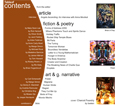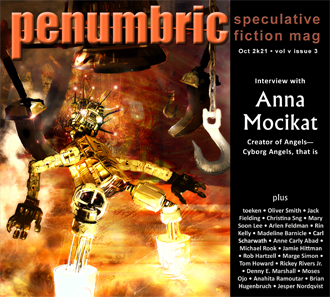From the Editor
by
Jeff Georgeson
previous next


full contents
interview
Anna Mocikat
From the Editor
by
Jeff Georgeson
previous

full contents
next

interview
Anna Mocikat
From the Editor
by
Jeff Georgeson
previous next


full contents
interview
Anna Mocikat
previous

full contents
next

interview
Anna Mocikat
From the Editor by Jeff Georgeson
From the Editor
by Jeff Georgeson
Twenty years ago I wrote an article in this very magazine claiming that cyberpunk was not, despite popular (Western) opinion, dead, and proceeded to list all sorts of then-current or recent books and stories (and even, very obliquely, video games) as some sort of irrefutable evidence that I was right. And, insofar as I listed a lot of anime and manga as part of my evidence, I was right ... but I told a very limited part of the story.
So my 2003 article was very ... unaware. Of things politically, of the appropriation of Asian everything as background, of the centering of male characters and the reduction of female roles to those of “basic pleasure model,” sexualized versions of the boss’s niece, and (even though once part of an “off-world kick-murder squad”) exotic dancer. And unaware of the fact that the Asian examples I do mention are from that cultural perspective, rather than a Western one. Politics, gender, otherness, race ... all, somehow, was blissfully la lala’d out of it; instead, my focus was on the low-hanging fruit of evil megacorporations and their misdeeds. And that’s because, growing up as a middle class white kid in the middle of America in the middle of the 80s, my focus was elsewhere. I’d bought into the idyllic vision fed us in my childhood in the 70s that everything was being solved, that the Civil Rights Act from before I was born and the ERA that was being fought over in Congress were all just examples of the country going in an inevitably more inclusive and equal direction, that the Black people and strong women on television were just more indication of this, and that even though Reagan was in the White House people’s rights wouldn’t be rolled back for anything; our “only” worries were global thermonuclear war and the power of growing megacorporations—and the 90s seemed to do away with the thermonuclear war. I wasn’t fully cognizant of the inherent and continuing centering of the white male in the science fiction I read, the actual ways in which the established order could pay lip service to equality while also winking and nodding at white supremacy, all while telling us to fear the Other (which I thought was ancient history once Communism was “defeated” and was relegated to old films like Invasion of the Body Snatchers, even though America continued ... and continues ... to call anyone approaching its borders an “alien” or worse).
I suppose I’m wallowing in my own ignorance; and indeed, it’s not like I didn’t read female scifi authors like Anne McCaffrey and Ursula Le Guin, not like I didn’t see and absorb stories that centered female protagonists (like Motoko Kusanagi in the original Ghost in the Shell film, or all four central characters in Bubblegum Crisis, or Serial Experiments Lain), but somehow in some, or many, ways I was just, again, unaware.
So in addition to our amazing interview with Anna Mocikat (author of Behind Blue Eyes and other stories), I was going to write an article discussing Western cyberpunk and its decentering and fetishization of both women and Asian culture and people while also pointing out that all of these groups have been writing a different kind of cyberpunk all along. Actually, I flatter myself: I was likely going to go in this sort of direction, but it really came into focus when my best friend (who is Asian-European) and I talked about it in more depth.
So, being me, I barreled ahead with research and writing, and even though there were a thousand other things to get done as well, I did in fact finish a couple of drafts of that article. And I touched on all those things we’d discussed: The original backgrounding of female characters and fetishization of Asianness in Blade Runner, the simultaneous (or actually prior) version of cyberpunk in Japan as done by Sogo Ishii in Crazy Thunder Road, leading into a host of cyberpunk anime with Akira, Bubblegum Crisis, Lain, and of course Mamoru Oshii’s Ghost in the Shell. I then went back to Hollywood and pointed out how it still, even now, isn’t getting this right, with the whitewashing and Asian stereotyping in the 2017 live action Ghost in the Shell and the continued white-male-centering in Blade Runner 2049. I wrapped up by talking about all the female and Asian American authors and artists who are contributing to the cyberpunk scene now, from Larissa Lai (The Salt Fish Girl; The Tiger Flu) to Marie Lu (Warcross). Oh, and then (because apparently “wrapping up” means something different to me) I talked about the same sorts of issues in videogames, because one can’t ignore Cyberpunk 2077 and its host of ills, and the Asian creators who have made games different than this and with a different sensibility.
And yes, the article came across as just that sort of whirlwind tour, which seems typical of some of the things I’ve written in this magazine and really doesn’t offer much new (and I really could just offer a list of good titles and let you all go read/watch them, yes?). And it all seemed to be missing something ...
Oh, right. The culture I’m talking about—actual Asian voices. And female voices (excepting that interview, which you should go read!).
I had managed to talk at length about all the things that decentered Asianness and femaleness, while talking about Asian and female works but ALSO decentering that culture and group by, in effect, talking at or about them rather than WITH them. And why was I talking about it at all, especially since, as I said, I wasn’t really adding anything to the discussion but a list, with a few choice comments here and there about what I thought good or not so good. And I’d managed to do it this way, blinders on, deadlines approaching, all the way until it was too late to rescue this train wreck of an article, too late to contact Asian or female writers (again, beyond our interview) about these issues, or better yet, ask someone more appropriate to write about it.
I feel absolutely terrible about this. There is a need for this discussion, but that will need to wait, in this magazine, for another time, when it can be done right. I am not throwing up my hands like Hollywood and giving up, whining that it's just sooo hard; I promise you that Penumbric will cover this, but it will do it much better than it was about to.
In this issue we also have other cyberpunk (or cyberpunkish) works, all very, very good stories that I am proud to publish. Jamie Hittman’s “Hunger in America” speaks to exactly the kinds of class and technology issues cyberpunk is famous for (“high-tech, low life”). Mary Soon Lee’s “Forms of Address 2050,” Marge Simon’s “Tomorrow Woman,” Rickey Rivers Jr’s “Creator and Creation,” and Anne Carly Abad’s “The Tuning” can be read as living the mechanical/cyborg/virtual life, while Rob Hartzell’s “Where Phantoms Touch and Spirits Dance,” Michael Rook’s “Boundless Vendettas,” and Arlen Feldman’s “Bit Parts” give us very different looks at our virtual afterlives. Oliver Smith’s “Holiday Traffic” drives us through a neon world; Madeline Barnicle’s “Letter to a Young Mathematician” speaks to more than just the human; and “Rocket Ship Temple Blues” by Jack Fielding takes us into both cyberpunk and the Twilight Zone—which then becomes the surreal in the late Rin Kelly’s “Breaking News.” We finish the text portion of our show with Brian Hugenbruch's “Droplets,” in which all our cyberpunk dreams may be just that.
In addition to the amazing cover art by toeken (Charcot Foundry), we feature cyberpunk-ish works by Carl Scharwath (Polish) and Denny E. Marshall (Human Stride). Our other art is probably best linked by calling it “cyberpunk-adjacent”: it takes on cyberpunk qualities by being amongst the other works. These include amazing art by Marge Simon (Migraine), Anahita Ramoutar (Regret), Christina Sng (They Cut Me Up), and Moses Ojo (Birds of Prey). Jesper Nordqvist’s continuing cyberpunk saga Mondo Mecho rounds out the issue.
See you in December!
Jeffrey Georgeson
Managing Editor
Penumbric











